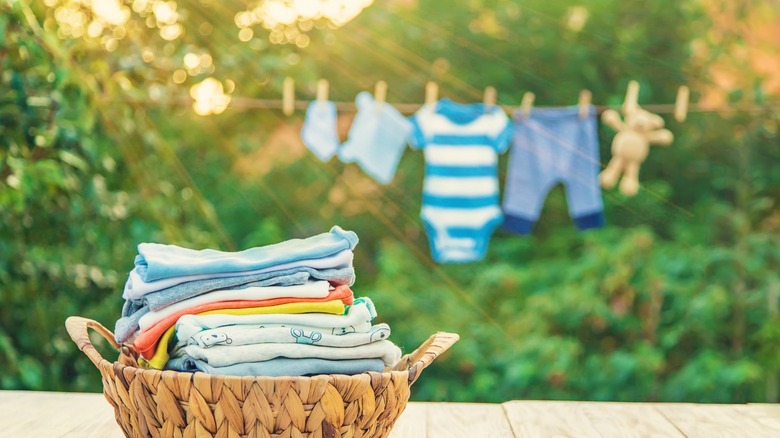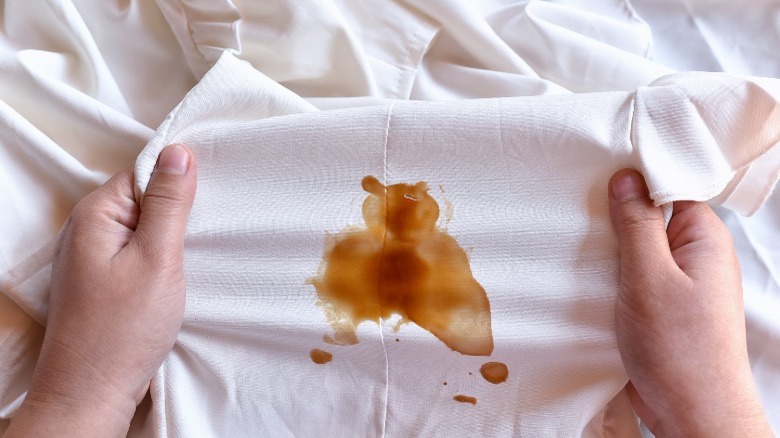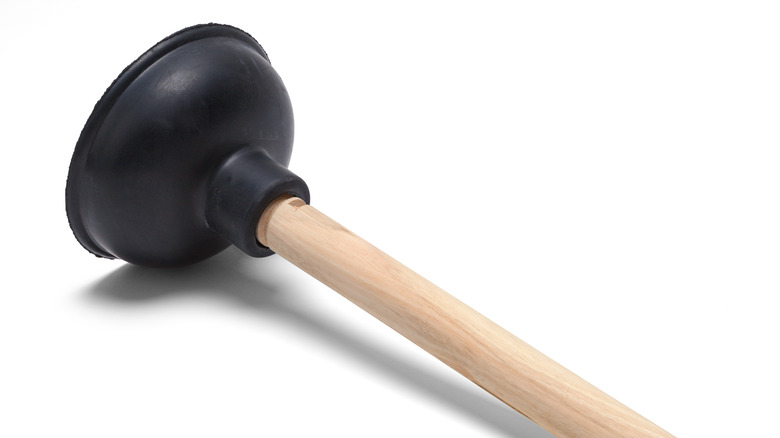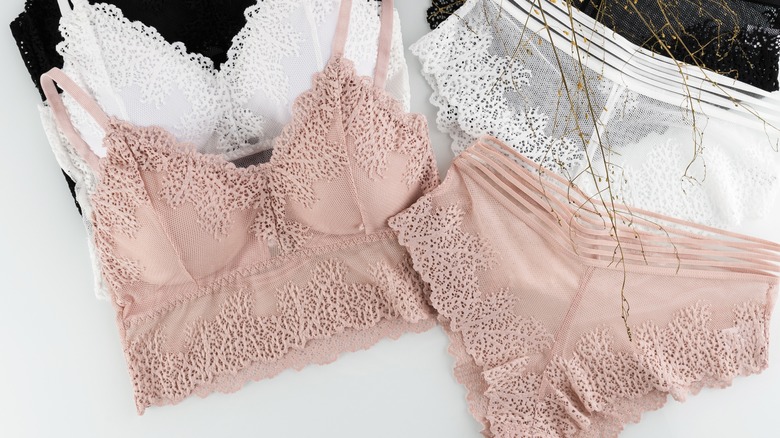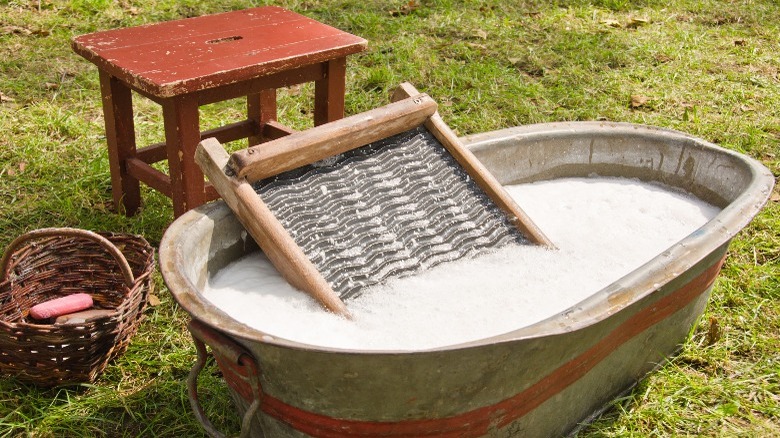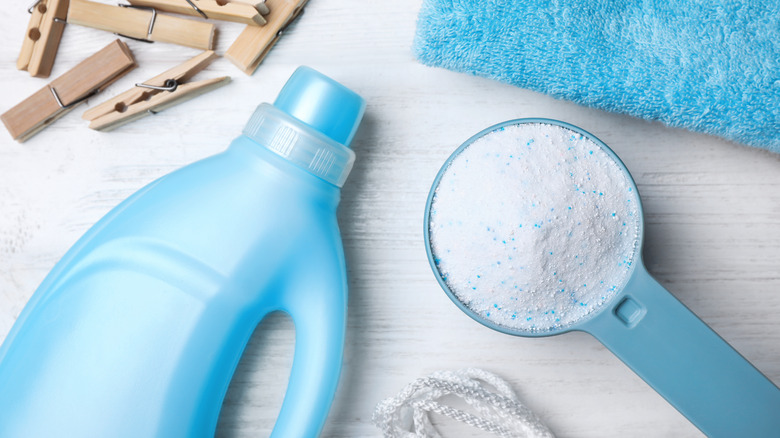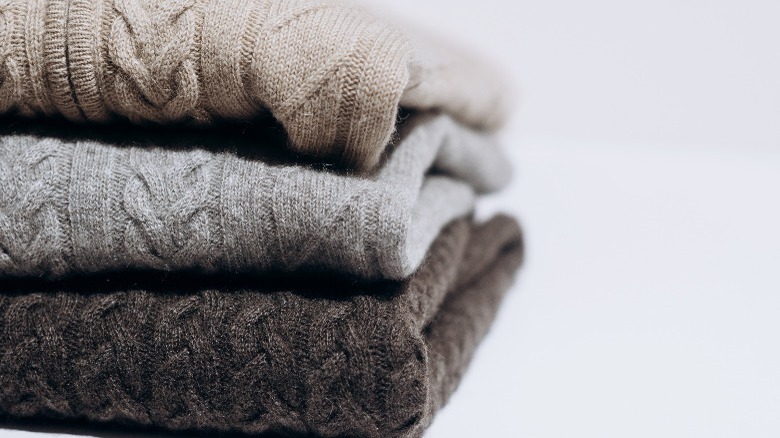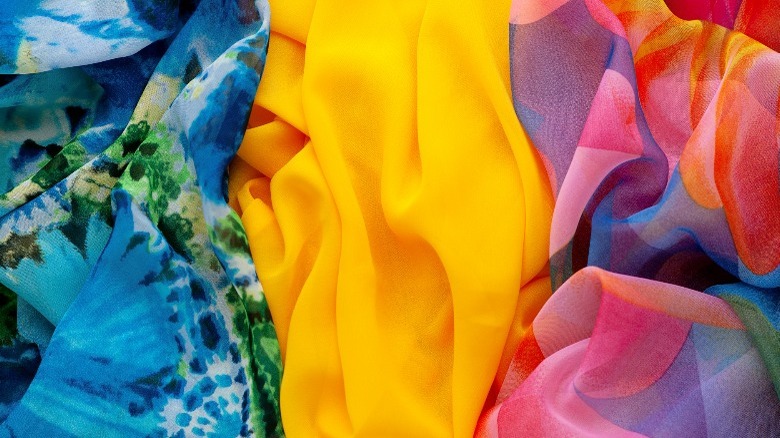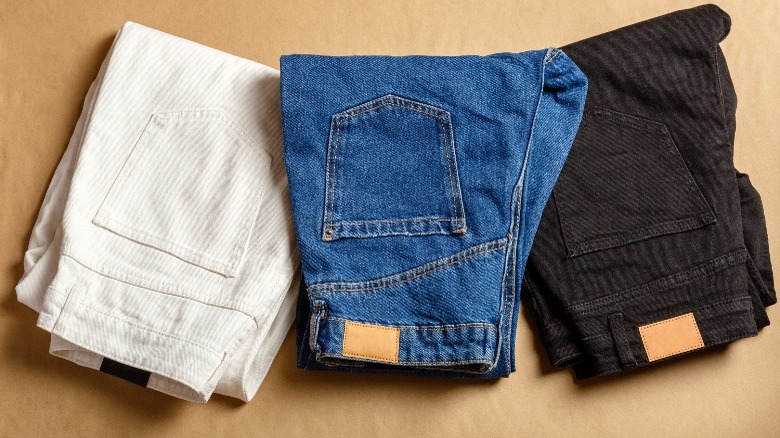The Best Way To Clean Your Clothes By Hand
Some situations happen in life that may leave you without a washing machine. While it's definitely a pain in the you-know-what, thankfully there are ways to clean our clothes without one. That's what our not-so-ancient ancestors did, after all! Remember that certain types of clothes and materials are labeled with special care instructions you should always follow carefully, including what temperature to wash them in. Many of us already wash delicate items by hand, but is there a specific way we should do it? What about regular clothes? Is there a wrong way and a right way? Actually, it turns out there is! And we've got the answers covered, regardless of your washing question or situation. But before we jump into the best methods for handwashing clothes, here are a few things to remember to do.
Make sure you separate light-colored clothing from dark, and by material when necessary. You'll also want to clean out the washing basin of your choice, whether it be a kitchen sink, a bathtub, a bucket, or any other kind of washtub. The Hamperapp reminds us to be sure to remove any leather, wool, or silk items for individual care and skip the pre-soaking, or you will likely damage the fabric. Additionally, turn all your garments inside out before washing them. Avoid the dryer whenever possible, as it can damage materials and shorten the life of your clothes. You'll also want to remember not to twist or wring out wet clothing, as this can stretch them or misshape them permanently. Now that you have these rules in mind, let's discuss the best handwashing methods. If you spend a lot of time trying to get out of laundry day, don't worry, we'll have loads of fun!
Pre-treat stains / universal method
Regardless of which method you decide to use, pretreating stains is a must. The American Cleaning Institute reminds us that this is important because if a stain doesn't get treated or doesn't come out and ends up in the dryer, it will set into the clothing and become nearly impossible to get out. Depending on what kind of stain it is, the methods will vary for how to do this effectively, but for most stains, you need to wet the area with cool water and put some stain remover on for about 15 minutes before washing. However, some stains should be laundered in cold water, some warm, some hot, and some stains should be treated entirely differently.
For example, chocolate is soaked in cool water first, then pretreated with stain remover, and finally washed in the hottest water the material can withstand. For a ketchup stain, pass cool water through the backside of the splotch and avoid dabbing into the material, so you don't spread the stain. It is noted that for ink stains, certain inks may be impossible to remove. You can try taking the stained area and stretching it over the top of a jar. Then take rubbing alcohol or cleaning fluid and pour slowly through the stain, so the ink drips out into the jar.
As you can see, the type of stain you're dealing with is important. If you're not sure, use the standard of soaking in cool water, then pretreat with stain remover for at least 15 minutes before washing. No matter what method you choose, this step should be followed; thus, the universal method.
Bucket and plunger method
According to Fluff Love University, this method is good for washing things like cloth diapers or small loads. This is additionally a great method to use while camping, as it works best outdoors. Survivopedia says you'll need just a few basic items, including two 5-gallon buckets (at least one must have a lid), a drill, and a (new) plunger. Drill holes with a spade bit or a round hole bit in one of the buckets, on the sides and the bottom. The idea is to mimic the washbasin of a washing machine, so drill about four to five nickel-sized holes in a row, going up and down the bucket, around the circumference of the bucket. You can space the rows about 2 to 3 inches from each other. Then put holes in the bottom, spaced as evenly apart as possible. Now make a hole dead center of the bucket lid that will fit the handle of the plunger through perfectly, and allow it to move up and down freely but also snugly.
Lastly, use a general-purpose drill bit to put multiple smaller holes in the rubber suction cup of the plunger. Assemble it by placing the bucket with holes inside the other bucket, then set the plunger in the center of the bucket while you add enough water to dissolve any powder soap and swish it around. Put clothes in, and add water to 1 inch from the top. Place the lid over the top of the plunger, insert the handle into the hole, and secure the lid well. Operate by taking the handle and moving the plunger vigorously up and down approximately 50 times, then wait five minutes and do another 50 strokes. It works quite well!
Grape stomp method
This is a fun method, especially if you have kids to entertain. Chunky Monkey Cloth Diaper Talk tells us about the grape stomp, sure to be a hit with bored kids and frustrated moms. If you happen to use cloth diapers, washing them can be a smelly, dirty job — but the grape-stomp method was designed with this in mind and will make short work of it. Now, you will need a bathtub for this method, but it's ideal because you can do more clothes or diapers at a time. Even if you don't have kids, it's a chore you can have fun with. Depending on how much you're washing, fill the tub about half full with the warmest water possible and the right amount of laundry detergent. Spread clothes or diapers in the water and soak for 15 to 30 minutes, depending on how soiled the clothes (or diapers) are. Soaking them first is said to boost cleaning power by a lot.
Next comes the fun part. Put on shorts and a T-shirt, ensure you and any kids who may be helping have clean feet, and start stomping like there's no tomorrow! Pretend you're stomping grapes; you'll want to agitate them for about 15 minutes straight. Then drain the tub and stomp as much water out as possible before filling it again with cool water. If you like, add some white vinegar to help disinfect diapers in particular. Stomp for another five minutes, rinse thoroughly, and drain. Press the water from diapers or clothes and hang them outside to dry in the sun.
Delicate wash method
Most women know they should wash their delicate clothing by hand, but it's hard to find the time — and just adding them to a load in the washer is so much more convenient! However, The Laundress tells us it's important to do this by hand to keep these items in excellent condition and make them last longer. Delicates are considered bras, underwear, nylons, bathing suits, etc., and require a little extra TLC. These items don't do well in the washing machine due to the mechanics of the agitator, and sometimes the straps can get caught in it as well. Washing items by hand is the best method for preserving the quality and life of your garments.
First, pretreat any stains and turn the garments inside out. Prepare your wash basin with room temperature water and a delicate laundry soap like Woolite. Then you will put the items in the soapy water and wash them with your hands, taking care to be gentle. Without rinsing, leave the things to soak for about half an hour. At this point, drain the water and begin rinsing each item under cool running water until all traces of soap are gone. Then press each item against the side of the basin to shed as much excess water as possible without wringing or twisting the garments. Take a large bath towel and set one or two items in the center, arranging them in their original form. Wrap them in the towel, and pat dry before hanging them in the sun to finish drying. Even if you have a washing machine, always wash delicate items by hand.
The washboard method
According to Villagers, the washboard method is an excellent way to clean your clothes when washing them by hand. Washing with a washboard is how we used to do it before electric washing machines came on the market. So if you don't have a washer at the moment, a washboard is the next logical thing. You don't need electricity, and you'll be surprised how much it helps. The first version in the United States was in 1833 by Stephen Rust (via Tennesse Virtual Archive). With the advent of the electric washing machine, washboards mainly became obsolete. So, it's not always easy to find one, but they're out there. Besides the board itself, you will need two large basins, preferably made out of plastic or galvanized metals that don't rust.
Michigan State University Museum recommends grabbing either a washtub or bucket and filling it partway with hot, soapy water. Put the clothes you want to wash into the basin to soak for about 20 minutes. Afterward, take the washboard and put it in the bucket feet first. The idea of the washboard is to act as an agitation aid, so you'll take each garment and rub it up and down the ridges, in and out of the water, until the items are thoroughly clean. Keep in mind that no matter how you clean your clothes by hand, you will need to supply some elbow grease — so choose the easiest method for your individual circumstances. Anything that aids the monotonous task should be welcomed!
Water-only method
According to In The Wash, this method is actually viable. Some people may prefer not to use soap for various reasons. Additionally, there are times when you might be out of detergent and unable to get to a store right away. Whatever the case, you can wash your clothes with only water and get them clean since the water, not the detergent, does most of the heavy lifting when cleaning your clothes. We use soap because it helps permeate the fibers of the clothes by softening the water. It also aids with oil-based stains since it has surfactants, which are molecules that lift dirt and grease off your dirty laundry. Water alone has a tough time doing this, but here are some tips for water-only washing.
If you want to skip detergent, you should only do laundry that can be washed in hot or warm water. As we know, hot water cleans better and eliminates more germs than cold water. Hot water helps open the fibers in the clothes to help release the dirt, while cold water does the opposite, causing the fibers to contract. However, cold water works better on certain kinds of dirt like sweat and blood, so the tip here is to pre-soak them in cold water first. Furthermore, if you are washing with water only, you'll have to be more aggressive with your agitation and do loads with fewer pieces at a time, changing the water often.
Make your own liquid laundry detergent method
It's only fair to include the method that utilizes homemade laundry detergent or soap! The recipe is from Rootsy and has just three ingredients. The cost is next to nothing compared to buying laundry soap products in the store, and your clothes get just as clean. You will need 1/2 bar of soap, 1 cup of Borax, and 1 cup of washing soda. If you can't find washing soda, buy a large container of baking soda and turn it into washing soda in the oven. That's right, I said in the oven. Take 1 cup of baking soda and spread it across a baking sheet. Put it into an oven preheated to 400 degrees for at least an hour. When its texture changes from silky to coarse, like the consistency of laundry detergent, a chemical reaction occurs that makes it into washing powder.
Take the 1/2 bar of soap and grate it into a large pot; add 1 gallon of hot water to dissolve completely. Then add the remaining two powder ingredients and bring to a boil. Be careful and don't leave the pot, because the liquid is thick and as soon as it boils it will boil over if you're not careful, creating a sudsy mess. Remove from heat and add 1 gallon of cold water; mix thoroughly. You have made two gallons of your very own homemade laundry detergent for less than $10! You can use it with any hand-washing method here or in a regular washing machine, and it works great. Add a few drops of essential oil for scent if you like.
Wool and cashmere method
The New York Times notes you can handwash wool or cashmere sweaters approximately once every seven to 10 times you wear them, which makes the material easier to care for if you ask me! Of course, that's not the entire story. Wool and/or cashmere should never be put in the washing machine or dryer, and you should never use any bleaching product. Always use delicate laundry soap or baby shampoo, and treat any stains immediately so they don't set in. You can use a little baby shampoo or Woolite on a cotton swab, rub it into the stain, then let it sit for at least 30 minutes. Then rinse with cool water, or wash the sweater or garment if it's time.
To wash wool or cashmere, use lukewarm water and mild soap, then submerge the item in the soapy water and move it around gently. Leave it to soak for about 15 minutes, swirling occasionally. After that, rinse with cool water, taking special care not to put it directly under the sink's running water. Once finished, remove excess water by pressing it out, laying it flat on a bath towel, and rolling it up to get the excess water out. Then you'll want to get another bath towel and lay the garment out to reshape and dry. Do not hang it up to dry, as it will stretch the material. Keep drying flat on the towel. Another thing to mention is that you should always wash your cashmere or wool just before summer, when you pack it away for the rest of the year.
The silk method
For instructions on the silk method, we go to Tide, which says you can clean this delicate fabric at home as long as the label doesn't say "dry clean only." The word "only" is the key here; if the label says "dry clean," it's just a recommendation, and you can safely hand wash the item at home. Additionally, do not dry silks in the sun. Keep them away from direct sunlight because it can damage the color and the material. Also, do not put it in the dryer, as this material is susceptible to damaging and shrinking. Silk items can be hung up to dry, or if you prefer to lay them flat on a towel, this is also fine.
First, fill a washtub with lukewarm to cold water and put the item in the water. Then add the appropriate amount of gentle detergent like Woolite and mix with your hand, swirling everything together well. Soak the garment for about three minutes before agitating it up and down in the soapy water. Don't be surprised if your silk garments bleed if they are colored, so be sure to wash them separately. Additionally, Real Simple says to soak the garment after agitating for approximately half an hour before rinsing with cold water. It also advises turning silk garments inside out before washing. These measures will ensure you feel like a million bucks in your luxurious silk items for years to come.
The denim method
This method is especially helpful if you just bought a pair of skinny jeans that look really good on you, and you're afraid to wash them for fear they'll lose their great appearance. Believe it or not, denim is a fabric that greatly benefits from hand washing. There's actually quite a bit to this, so let's get started by making sure your pockets are empty, they are zipped or buttoned up, the cuffs are rolled out, and it's turned inside out.
Denimhunters recommends using a bathtub, if possible, or a large basin and filling it with lukewarm water. You'll want to use a mild detergent for delicates or black fabrics; nothing with bleach. Add a little of that, and then add ½ cup of white vinegar and mix it well. Put the jeans in the water and agitate. Afterward, let them soak for at least one hour before thoroughly rinsing, and hang to dry. Doing this will give you results you'll love and help your denim last for a very long time.
